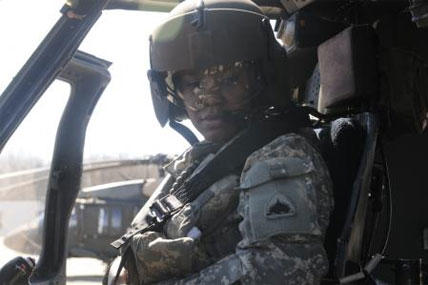WASHINGTON - The District of Columbia National Guard is celebrating Women’s History Month with a landmark: Army 1st Lt. Dina Elosiebo earned her Army aviator wings after completing Initial Entry Rotary Wing Flight School at Fort Rucker, Ala., making her the first female African-American pilot in D.C. Army National Guard history.
“This is an extraordinary, historical event for us,” said Maj. Gen. Errol R. Schwartz, commanding general, D.C. National Guard. “We’re extremely proud of Lt. Elosiebo. She’s a fine officer, and now, Army aviator.”
Schwartz said every pilot who graduates from Fort Rucker’s rigorous aviator training course - male, or female, regardless of their race or ethnicity - has accomplished something special.
He added that the military has moved well past the days when such accomplishments were unusual.
“The diversity of our armed forces is what makes us strong," Schwartz said.
While completing the course is no cake walk, Elosiebo, now a platoon leader with D Company (Air Ambulance), 1-224th Aviation Regiment, had a leg up on most other students at Fort Rucker. In her civilian career, she previously earned her FAA commercial pilot’s license and became a certified flight instructor.
Elosiebo follows in the path of the famous Tuskegee Airmen, the first African-American fighter pilots. Before World War II, black pilots were barred from earning their wings in the Army Air Corps. The Pentagon's rationale was that African-Americans could not be taught to fly. But after being forced to go through pilot training three times before being sent to the fight, they became the best of the best. In the bomber escort missions that they flew in Europe, they never lost a bomber.
Elosiebo has a strong connection to the Tuskegee Airmen. She received one of her many academic scholarships from one of their association chapters, and they supported her when she began pursuing her private pilot's license at age 19. In addition, she has worked with, and been mentored by, these living legends, including Herbert Jones, who formed the first African-American-owned airline in the U.S.
Women pilots during WWII - the Women's Air Force Service Pilots, or WASPs - also inspired Elosiebo. More than 1,000 WASPs flew during the war. Their primary mission was to ferry military aircraft from factories to bases around the country.
Elosiebo is scheduled to make her first flight this week with her aviation unit at Davison Army Airfield, Va., which serves Fort Belvoir south of Washington.
"When I think about the trailblazers who went before me and the adversity they continuously faced, be it gender, ethnicity, or simply doing what had not been done, I am grateful. I realize that I may not have a story had they not been inspired and laid the foundation," Elosiebo said.
Elosiebo learned to be a go-getter early on in life. As the oldest child, she soon realized that whatever calamity might occur when she was left in charge of her younger siblings, she was going to have to answer for it. So she took charge, and she took responsibility. She's never looked back. She served as class leader during UH-60 qualification and again during Survival Evasion Resistance and Escape training.



























